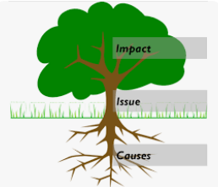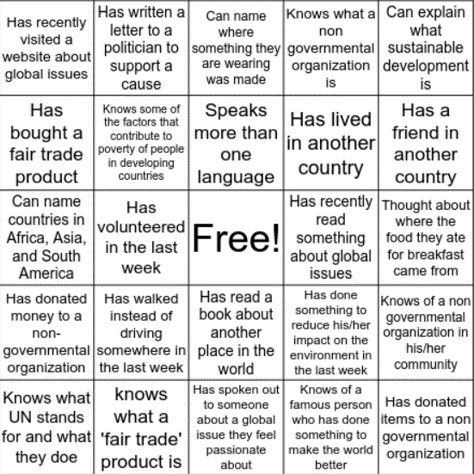Activities
Sustainable Development Goals:
Step 1: Print out the SDGs and place them on the ground. Give each young person three sticky notes (small pieces of card) and ask them to place them on top of the SDGs that they feel are most important.
Step 2: Use the activity of ‘pair share’ and ask the young person to speak to the person beside them and state why they chose each SDG.
Step 3: In plenary, discuss the following questions:
- What SDGs did you pick and why? (select a few young people from the group)
- Did you change your mind based on your discussion with your pair? (select a few young people from the group)
- Do you think the SDGs will make a difference in your community/country?
- What is needed globally to achieve the SDGs by 2030?
- Open question – youth worker to add additional questions
Active Citizenship:
Step 1: Youth worker distributes the bingo cards attached in the next slide (downloaded from bingobaker.com)
Step 2: The youth worker goes through the cards playing bingo until the game is won.
Step 3: The youth worker facilitates a debrief discussion and asks the following questions:
- Did any of the group actually complete anything stated on the bingo cards?
- Why would it be important to complete any of the statements on the bingo cards?
- Is there something in your community you would like to do in the foreseeable future?
- How can the youth organisation support them to become active citizens?
Global Citizenship Education:
Step 1: After giving a general presentation and showing the videos in this module, the youth worker divides the group into smaller groups of 4 people.
Step 2: The groups are given flip charts and markers and asked to draw a large tree (‘the problem tree’).
Step 3: On the tree, the group is asked to write on the bark of the tree one issue they are passionate about ie. gender inequality. They are then given 30 minutes to think about the causes of said issue ie. the gender pay gap, and place them in the roots of the tree and the effects of said issue ie. inequality in the workplace. The group is asked to write as many causes and effects as they can think of.
Step 4: Debrief with the group what this represents and how they felt about taking part. Questions to consider:
-Why is it important to think about the causes and effects of societal issues
-Is it important to think about how different societal issues are connected and their impact?

Photo source: childreninemergencies.org (2016)
